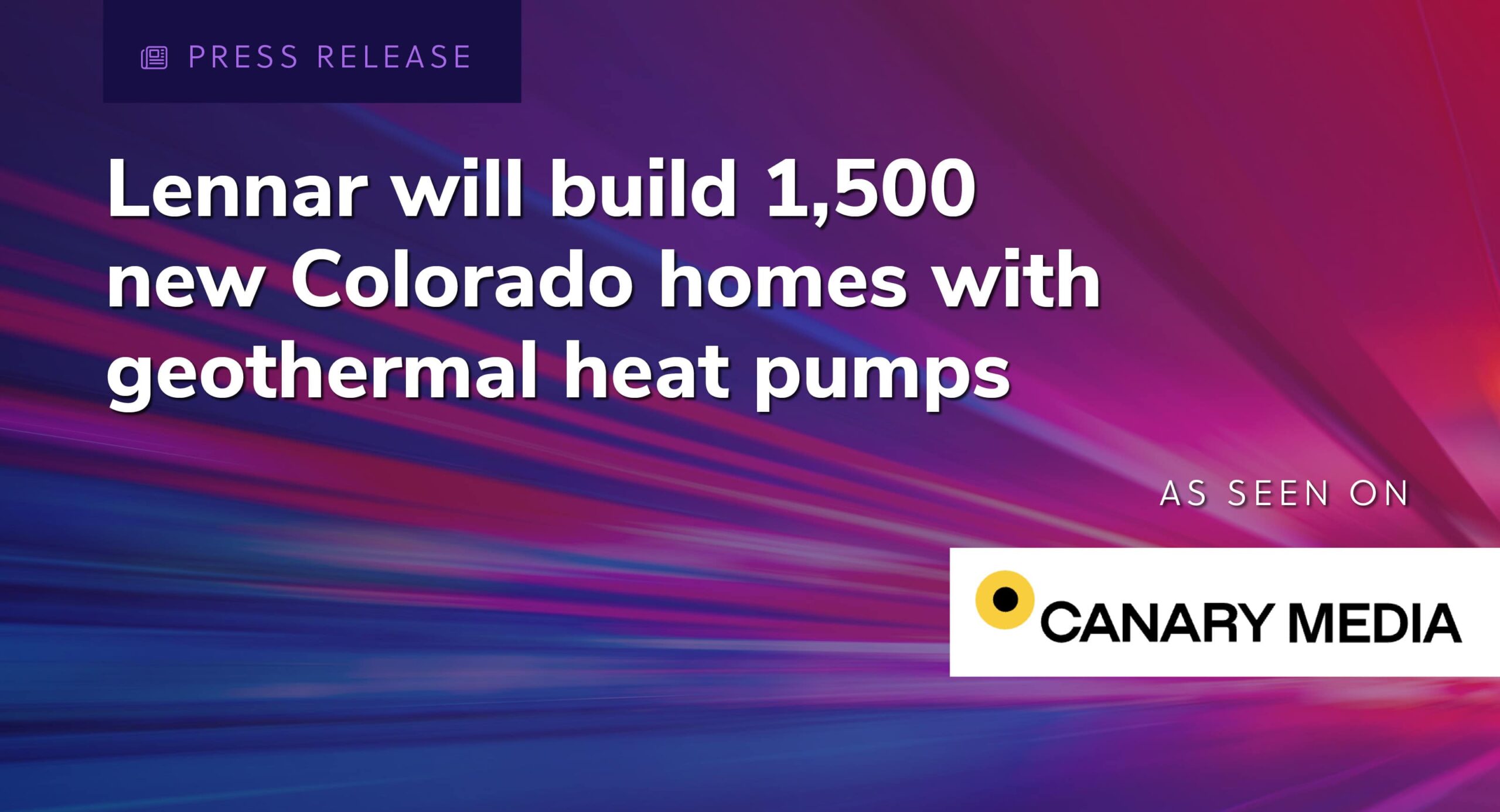
The homebuilder is partnering with Dandelion Energy to install the tech, which is efficient but expensive — unless it’s built into new homes from the start.
Ground-source heat pumps, which tap into the stable temperatures found hundreds of feet beneath the Earth’s surface, are a super-efficient way to heat and cool homes. They’re also quite expensive to install in existing houses.
There’s a pretty straightforward reason: It’s hard to drill in a residential neighborhood. Hiring contractors to fit rigs into tight single-family yards and drill boreholes in places where utility infrastructure crisscrosses underfoot is a lot more complicated and expensive than installing an air-source heat pump, fossil-gas furnace, or other standard, aboveground HVAC systems.
But what if you could bore hundreds of holes at a time across a patch of cleared land and then build heat pump–equipped houses on top of them? That should be a lot cheaper. In fact, it could make ground-source heat pumps about as cheap as traditional HVAC offerings in newly built homes.
On Wednesday, Google X spinout Dandelion Energy and major U.S. homebuilder Lennar unveiled a partnership that aims to prove that proposition. The companies have pledged to build ground-source geothermal into more than 1,500 new homes in Colorado over the next two years, starting with Lennar’s Ken-Caryl Ranch development in Littleton, Colorado.
The goal is simple, Kathy Hannun, Dandelion’s founder and president, told Canary Media: “Can you get the up-front cost to be lower than everything else? Because then you have no reason not to do it.”
Just being able to tackle hundreds of boreholes at a time should more than halve the drilling costs that burden existing home retrofits, she said. Large-project economies of scale and designing homes around the high-efficiency heating and cooling that Dandelion’s system provides will yield further cost reductions, she said.
And by eliminating the need for new gas pipelines and reducing the peak electricity demands on the power grid, subdivisions built on this model could save a bundle on utilities as well, she said. That’s a key benefit cited in a January report from the Department of Energy, which found that widespread adoption of ground-source heat pumps, also known as geothermal heat pumps, could cut hundreds of gigawatts of peak demand and tens of billions of dollars in grid costs over the coming decades.
That study also found ground-source heat pumps could make a big dent in residential energy consumption and carbon emissions, particularly in climates where they outperform air-source heat pumps during cold winter weather.
But as it stands, the technology is in no more than 1% of U.S. homes, the report found. For comparison, air-source heat pumps are now in about 13% of U.S. homes.
The chief barrier, once again, is the up-front expense. Dandelion has spent the past eight years working to bring down those costs through a combination of technology and business-model innovation, and has done more than 1,000 home retrofits in the U.S. Northeast, targeting homes with high heating costs, many of which use expensive fuel oil.
To break into larger volume deployments, Dandelion has shifted its focus to new construction over the past two years or so, Hannun said. That pivot has naturally included Lennar, an investor in Dandelion that now owns about 10% of the startup, she said.
Colorado’s push for geothermal energy
Lennar and Dandelion aren’t disclosing cost data for the homes they’re collaborating on in Colorado. But, Hannun said, “in a few markets, the up-front cost of geothermal today is less than conventional” heating.
That’s certainly the case in Colorado, where Gov. Jared Polis, a Democrat, has made geothermal energy, or “the heat beneath our feet,” as he’s dubbed it in various state and regional policy initiatives, a big part of the state’s broader decarbonization strategy.
Over the past few years, the state has passed legislation creating tax credits for heat pumps, including ground-source systems, and competitive grants for geothermal energy projects. It also passed a law in 2021 that spurred Xcel Energy, the state’s largest utility, to launch a Clean Heat Plan that will provide significant rebates to projects that improve energy efficiency and help customers switch from gas to electric heating.
“The rebates coming out of Xcel’s Clean Heat Plan played a really significant role in the ability of the Dandelion-Lennar investments to pan out,” said Will Toor, executive director of the Colorado Energy Office, which manages state energy programs.
The government and utility incentives will also lower costs for people who aren’t buying these homes, because geothermal heat pump systems reduce the need for other utility infrastructure, he noted.
All-electric homes don’t need new gas pipeline extensions, the costs of which are typically recovered through increases on the bills of utility customers at large. And ground-source heat pumps need much less electricity than air-source heat pumps to keep homes warm during the coldest hours of the year, since they’re able to pull heat from deep underground thermal reservoirs rather than from cold outdoor air.
“There’s clearly some cost of putting in a geothermal system. But once it’s in there, it’s such an inexpensive approach to heating buildings,” Toor said. “If we can come up with creative ways to get these systems installed, we think it will help homeowners and businesses save money on their energy bills over the years.”
Power grids are sized to meet maximum electricity demand, so buildings that can reliably keep electricity use below certain limits minimize the need to build more grid infrastructure. These factors can make geothermal networks the least expensive option on a system-wide basis when the lifecycle costs of infrastructure and energy consumption are built in.
Xcel Energy is looking for ways to mitigate growing grid costs as it seeks regulatory approval to spend nearly $5 billion on its low-voltage distribution grid over the next five years, much of it to support growing power demand from heat pumps and electric vehicles.
“Based on our own research and forecasting, homes heated with ground-source heat pumps may require less electricity at peak and overall compared to homes with an air-source heat pump or resistance heating, therefore requiring fewer infrastructure investments on the grid,” Xcel spokesperson Tyler Bryant told Canary Media in an email. Xcel will study the grid impacts of Lennar and Dandelion Energy’s use of ground-source heat pumps to “inform future projects from a grid planning perspective.”
Neighborhood geothermal energy options
Hannun isn’t aware of other homebuilders embedding ground-source heat pumps into large-scale single-family construction, though they are being built into bigger buildings, including multifamily housing.
But there are similar, yet distinct, approaches for single-family homes to tap underground temperature reserves to save energy and cut carbon emissions.
One is thermal energy networks — projects that build the infrastructure needed for geothermal heat pumps at a campus-wide or neighborhood scale instead of serving just one home. Utilities in Massachusetts and New York are actively pursuing these projects as part of their states’ decarbonization strategies. Six other states, including California and Colorado, have passed legislation that allows or mandates gas utilities to develop demonstration projects or pilots, according to the Building Decarbonization Coalition.
“Geothermal heat pumps and thermal energy networks are a cost-effective way for utilities and developers to deliver clean, affordable heating and cooling, at scale, while minimizing strain on the electric grid,” said Ania Camargo, the nonprofit’s associate director of thermal networks. “The more geothermal systems we install, the better for the homeowner and the grid in the long run.”
Newly built neighborhoods can also incorporate thermal energy networks. A shared geothermal system will serve the 7,500-home Whisper Valley development in Austin, Texas. In Colorado, the housing authority serving Steamboat Springs is studying a community geothermal system for a new housing development.
Under a state law passed last year, Xcel Energy is examining several “neighborhood-scale alternatives to the gas system that can include both electrification and thermal energy network or ground-source heat pumps,” Toor said.
Hannun agreed that shared thermal energy networks are an effective way to approach neighborhood-scale geothermal heating. But they’re also more complicated to build and administer than individual ground-source heat pumps, particularly for entities that aren’t a regulated utility with state-mandated authority to provide energy services to customers. Lennar and Dandelion opted for single-home ground loops to avoid any complications that could arise from getting lots of homeowners to commit to a shared system, she said.
Not all homebuilders will embrace the additional costs of ground-source geothermal, she said. Developers don’t pay utility bills, incentivizing them to choose the lowest-cost heating and cooling options available. At the same time, nationwide homebuilders like Lennar “often offer new products to homeowners to try to stand out,” Hannun said, and ground-source heating has “traditionally been a luxury system.”
It’s also a straightforward way to meet state or local energy-efficiency building codes, she added.
Air-source heat pumps are inherently more energy efficient than fossil-fueled furnaces, since they use energy to move heat from one place to another rather than to create heat directly. But ground-source heat pumps can be more than twice as efficient as air-source models.
“These homes will have the lowest operating cost for HVAC possible,” Hannun said. “The homeowners will spend less than if they were using air-source heat pumps or if they were using gas. And that will be locked in for the lifetime of that home because that ground loop is built to last.”
Share this Post

